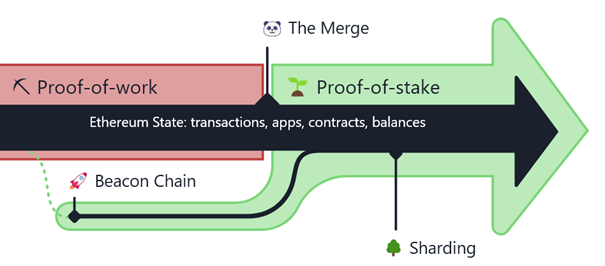- Ethereum Mainnet uses proof-of-stake, but this wasn’t always the case
- The upgrade from the original proof-of-work mechanism to proof-of-stake was called The Merge
- The Merge refers to the original Ethereum Mainnet merging with a separate proof-of-stake blockchain called the Beacon Chain, now existing as one chain
- The Merge reduced Ethereum’s energy consumption by ~99.95%
- The Merge was executed on September 15, 2022. This completed Ethereum’s transition to proof-of-stake consensus.

What was "The Merge"?
The Merge was the joining of the original execution layer of Ethereum (the Mainnet that has existed since genesis) with its new proof-of-stake consensus layer, the Beacon Chain. It eliminated the need for energy-intensive mining and instead enabled the network to be secured using staked ETH. It was a truly exciting step in realizing the Ethereum vision—more scalability, security, and sustainability.

The Merge was when these two systems finally came together, and proof-of-work was permanently replaced by proof-of-stake.
Imagine Ethereum is a spaceship that launched before it was quite ready for an interstellar voyage. With the Beacon Chain, the community built a new engine and a hardened hull. After significant testing, it became time to hot-swap the new engine for the old one mid-flight. This merged the new, more efficient engine into the existing ship enabling it to put in some serious light years and take on the universe.
Merging with the Mainnet
Proof-of-work secured Ethereum Mainnet from genesis until The Merge. This allowed the Ethereum blockchain we’re all used to come into existence in July 2015 with all its familiar features—transactions, smart contracts, accounts, etc.
Throughout Ethereum’s history, developers prepared for an eventual transition away from proof-of-work to proof-of-stake. On December 1, 2020, the Beacon Chain was created as a separate blockchain to Mainnet, running in parallel.
The Beacon Chain was not originally processing Mainnet transactions. Instead, it was reaching consensus on its own state by agreeing on active validators and their account balances. After extensive testing, it became time for the Beacon Chain to reach consensus on real world data. After The Merge, the Beacon Chain became the consensus engine for all network data, including execution layer transactions and account balances.
The Merge represented the official switch to using the Beacon Chain as the engine of block production. Mining is no longer the means of producing valid blocks. Instead, the proof-of-stake validators have adopted this role and are now responsible for processing the validity of all transactions and proposing blocks. No history was lost in The Merge. As Mainnet merged with the Beacon Chain, it also merged the entire transactional history of Ethereum.
Users and holders
The Merge did not change anything for holders/users.
This bears repeating: As a user or holder of ETH or any other digital asset on Ethereum, as well as non-node-operating stakers, you do not need to do anything with your funds or wallet to account for The Merge. ETH is just ETH. There is no such thing as “old ETH”/”new ETH” or “ETH1″/”ETH2” and wallets work exactly the same after The Merge as they did before—people telling you otherwise are likely scammers.
The Merge and energy consumption
The Merge marked the end of proof-of-work for Ethereum and start the era of a more sustainable, eco-friendly Ethereum. Ethereum’s energy consumption dropped by an estimated 99.95%, making Ethereum a green blockchain. Learn more about Ethereum energy consumption.
The Merge and the Shanghai upgrade
In order to simplify and maximize focus on a successful transition to proof-of-stake, The Merge upgrade did not include certain anticipated features such as the ability to withdraw staked ETH. The Shanghai upgrade is planned to follow The Merge, which will enable the ability for stakers to withdraw.

